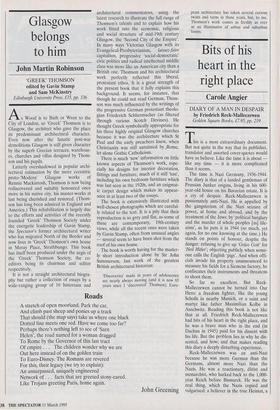Glasgow belongs to him
John Martin Robinson
`GREEK' THOMSON edited by Gavin Stamp and Sam McKinstry Edinburgh University Press, £35, pp. 336 As Wood is to Bath or Wren to the City of London, so 'Greek' Thomson is to Glasgow, the architect who gave the place its predominant architectural character. Even now after the lunatic post-war demolitions Glasgow is still given character by the superb Grecian terraces, warehous- es, churches and villas designed by Thom- son and his pupils.
Latterly overshadowed in popular archi- tectural estimation by the more eccentric proto-`Modern' Glasgow works of Rennie Mackintosh, Thomson is now being rediscovered and suitably honoured once more in his native city, his master-works at last being cherished and restored. (Thom- son has long been admired in England and America.) This rehabilitation is largely due to the efforts and activities of the recently founded 'Greek' Thomson Society under the energetic leadership of Gavin Stamp, the Spectator's former architectural writer who has migrated North of the Border and now lives in 'Greek' Thomson's own house in Moray Place, Strathbungo. This book has itself been produced under the aegis of the 'Greek' Thomson Society, the co- editors being its chairman and editor respectively.
It is not a straight architectural biogra- phy but rather a collection of essays by a wide-ranging group of 16 historians and
architectural commentators, using the latest research to illustrate the full range of Thomson's talents and to explain how his work fitted into the economic, religious and social structure of mid-19th century Glasgow, the 'Second City of the Empire'. In many ways Victorian Glasgow with its Evangelical-Presbyterianism, laissez-faire capitalism, progressive 'social-democratic' civic politics and radical intellectual middle class was more like an American city than a British one. Thomson and his architectural work perfectly reflected this liberal, protestant ethos. It is a great strength of the present book that it fully explains this background. It seems, for instance, that though he could not read German, Thom- son was much influenced by the writings of the progressive German protestant theolo- gian Friederich Schliermacher (as filtered through various Scotch Devines). He thought Greek symbolically appropriate for his three highly original Glasgow churches because it was the architecture which St Paul and the early preachers knew, when Christianity was still untainted by ,Rome, let alone Gothic Catholicism.
There is much 'new' information on little known aspects of Thomson's work, espe- cially his designs for interior decoration, fittings and furniture, much of it still 'lost', including his own bedroom furniture which was last seen in the 1920s, and an enigmat- ic carpet design which makes its appear- ance in at least two of the essays.
The book is extensively illustrated with well-chosen photographs which are careful- ly related to the text. It is a pity that their reproduction is so grey and flat, as some of these are contemporary, 19th-century views, while all the recent ones were taken by Gavin Stamp, often from unusual angles — several seem to have been shot from the roof of his own house.
The book is worth having for the master- ly short introduction alone by Sir John Summerson, last work of the greatest British architectural historian:
`Discoveries' made in years of adolescence are nearly always moving (and it is now 65 years since I 'discovered' Thomson). Euro-
John Greening
Roads
A stretch of open moorland. Park the car, And climb past sheep and ponies up a track That should (the map says) take us where one black Dotted line meets one red. Have we come too far?
Perhaps there's nothing left to see of 'Sam Helen', the road named for a woman dragged To Rome by the Governor of this last tract Of empire . . . The children wonder why we are Out here instead of on the golden train To Euro-Disney. The Romans are revered For this, their legacy (we try to explain): An unsurpassed, uniquely engineered Network of . . facts that are greeted stony-eared.
Like Trojans greeting Paris, home again.
pean architecture has taken several curious twists and turns in those years, but, to me, Thomson's work comes as freshly as ever as an illuminator of urban and suburban forms.


























































 Previous page
Previous page